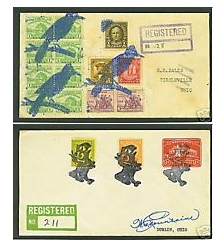Collecting 20th Century
Fancy Cancellations
By Bill Weiss
INTRODUCTION
Possibly as many as 2,000 different fancy cancellations exist from the period between the early 1920s to the mid 1930s, but this area of fancy cancel collecting is often misunderstood. It is the purpose of this guide to provide a brief background and explaination of this interesting and colorful collecting field.
First in 1910, and later in 1928, postmasters were instructed by the Postmaster General NOT to apply a dated postmark on the front of a registered letter. This directive however, failed to instruct the postmasters exactly how to "kill" the stamps on the front of mail. Although regulations would appear to call for standard markers to be used,swiss replica watches some postmasters saw this directive as an opportunity to create attractive and unusual devices to cancel the stamps. This practice primarily occured at fourth-class post offices.

Before long, collectors decided to carve fancy killers and were able to persuade the 4th-Class postmasters (whose compensation was based on the number of pieces they processed) to use the fancy killers on registered mail they deposited there. Although these fancy non-standard killers were technically contrary to regulations, it wasn't until the late 1930s that orders from Washington finally put a stop to the use of these killers. In the years before the practice was halted, both philatelists and postmasters created a multitude of colorful and interesting cancels, and many of them are unlike anything ever done before in terms of their colorful style and multiple strikes. Because of these directives and unclear instructions to the postmasters, it is clear that even though many of these fancy killers were inspired and/or created by philatelists, they constitute a legitimate collecting field.
RARITY
Some of these fancy cancels are exceedingly rare, and in some cases, only a few strikes exist. Cancels usually depicted a theme, or represented a pictorial design based on the name of the town, thus an antelope design was used in the town of ANTELOPE/MONTANA, a BEAR in Bear/Ark, a blue "R-O-C-K" in Blue Rock/Ohio, etc. Sometimes, if the town was well known for a particular product, that product would be depicted. If a special event, or holiday was being honored, the cancel depicted it. Only the imagination of the carver restricted the variety of killers made.
EARLY STUDENTS AND BOOKS
These fancy cancels have captivated five generations of collectors and in 1952, two of them, Foster Loso and Heyliger deWindt wrote the first catalog/book on 20th C. Fancy Cancels, which then was revised in 1987 by William Walker and H.R. Fishback. In 1987 a price guide "The Complete Pricing Guide of United States 20th Century Fancy Cancellations" was compiled by W. R. Weiss, Jr. Both the book and the pricing guide are long out of print and have not been reprinted or updated, and are only available in the secondary market from philatelic literature dealers. The present owners of the copyright of the Walker-Fishback book have stated their plans to publish a revision, but have not done so, and it is doubtful if they ever will, thus the 1987 books are the definitive, though certainly incomplete works.

TOPICAL APPEAL
While early collections of 20th C. fancies tended to be general in nature, they have taken on a new meaning in recent years as topical and thematic collectors avidly seek those that fit their topic. European collectors especially, have entered the marketplace and recognizing the rarity of many of these cancels, have caused tremendous upward swings in prices for the most desirable cancels. For example, the town of MICKEY/Texas featured a large cancel depicting of course, Mickey Mouse! Twenty-five years ago, this cancel, of which there are surely less than 10 known, would have sold for about $300. Today it is likely worth $3,000. The town of Talcville/NY is known for a group of 18 different pictorial killers showing, among other great topics, a turtle, a polar bear, an airship, a cat, a fish and a running chicken! Twenty years ago some of these sold for over $1,000. each as these killers are extremely rare with all less than five of each known, and only ONE complete set of all 18 is intact. It is possible that some of the individual killers could sell for upwards of $2,500. each. After this intact group is dispersed, it will become virtually impossible to aquire a complete set of the Talcville killers. During the 1929 Baseball world series the town of Genesee Depot/Wisconsin used a cancel depicting a bat, a ball and "WS" ("World Series") which was used on each day of the series. Only one complete set still is intact.

AFFORDABILITY
This collecting field however, is still quite affordable, with the majority of cancels available for under $100. each when used on registered-use covers. Note that uses NOT on registered covers are not held by collectors in nearly high esteem as registered covers. Why? Several reasons, some valid, some not. European collectors require that covers show a receiving stamp to verify that, in fact, it went through the mail. While normally a sensible view, unfortunately many 20th C. fancies only exist on first class mail, and NO registered uses are known. Registered uses are often more desirable, aside from the proof that they went through the mail, many RCs ("registered covers") bear multiple-stamp franking, thus bear more strikes of a killer than FC ("first-class") uses, and are thus more attractive and more colorful. Most FC uses are obtainable for under $50. each with the exception of some very good topicals which only exist as FC mail.
CONCLUSION
All in all, this is an affordable, interesting and colorful collecting field, which is highly recommended. It is ripe for new collectors who, like generations before them, will fall in love with these interesting cancels.





